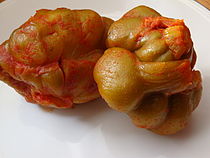Zha cai
Pickled mustard plant stem from Chongqing, China From Wikipedia, the free encyclopedia
Pickled mustard plant stem from Chongqing, China From Wikipedia, the free encyclopedia
Zha cai ([ʈʂâ tsʰâɪ]; 榨菜), also romanized as Cha tsai, is a type of pickled mustard plant stem originating from Chongqing, China. The name may also be written in English as cha tsai, tsa tsai, jar choy, jar choi, ja choi, ja choy, or cha tsoi. In English, it is commonly known as Sichuan vegetable, Szechwan vegetable, or Chinese pickled vegetable, although all of these terms may also refer to any of a number of other Chinese pickles, including the several other types in the Sichuan province itself.[1]
This article needs additional citations for verification. (March 2013) |
| Zha cai | |||||||||||||||||||||
|---|---|---|---|---|---|---|---|---|---|---|---|---|---|---|---|---|---|---|---|---|---|
 Whole heads of zha cai coated in chili paste | |||||||||||||||||||||
| Chinese | 榨菜 | ||||||||||||||||||||
| Hanyu Pinyin | zhà cài | ||||||||||||||||||||
| |||||||||||||||||||||

The pickle is made from the knobbly, fist-sized, swollen green stem of Brassica juncea, subspecies tsatsai. The stem is first salted and pressed, and dried before being rubbed with hot red chili paste and allowed to ferment in an earthenware jar.[2]
The taste is a combination of spicy, sour, and salty. Its unique texture—crunchy, yet tender—can only be vaguely compared to Western pickled cucumbers. Excess salt in the preserved vegetable is leached out by soaking in fresh water. Considered to be rich in umami, zha cai varies in spiciness depending on the amount of chili paste used in preparation.[3]

Originating in Sichuan and believed to be one of the world's oldest types of pickles,[4] zha cai is used in many of the various cuisines of China such as in Sichuan dan dan noodles,[5] in soups with ground pork and mifen, and as a condiment for rice congee.[6] It is generally sliced into thin strips and used in small amounts due to its extreme saltiness, although this saltiness can be tempered somewhat by soaking the strips in water prior to use.
A popular Chinese dish featuring zha cai is "noodles with Zha Cai and shredded pork" (榨菜肉絲麵; zhà cài ròusī miàn).[7] Zha cai is also an ingredient of ci fan tuan, a popular dish in Shanghai cuisine.
In Japan, the pickle is common in Chinese restaurants (though it is usually less spicy, to suit Japanese tastes), and it is transliterated into Japanese as zāsai (katakana: ザーサイ; kanji: 搾菜).
Like other vegetable stems in Chinese cuisines, particularly celtuce, zha cai can also be sliced and sautéed.
Fuling, a district in Chongqing, is closely associated with zha cai.[8] The largest manufacturer, Fuling Zhacai, manufacturers of the Wujiang (乌江, Wu River) brand, is listed on the Shenzhen Stock Exchange[9] and in 2021 celebrated selling 15 billion packets.[10]
Seamless Wikipedia browsing. On steroids.
Every time you click a link to Wikipedia, Wiktionary or Wikiquote in your browser's search results, it will show the modern Wikiwand interface.
Wikiwand extension is a five stars, simple, with minimum permission required to keep your browsing private, safe and transparent.